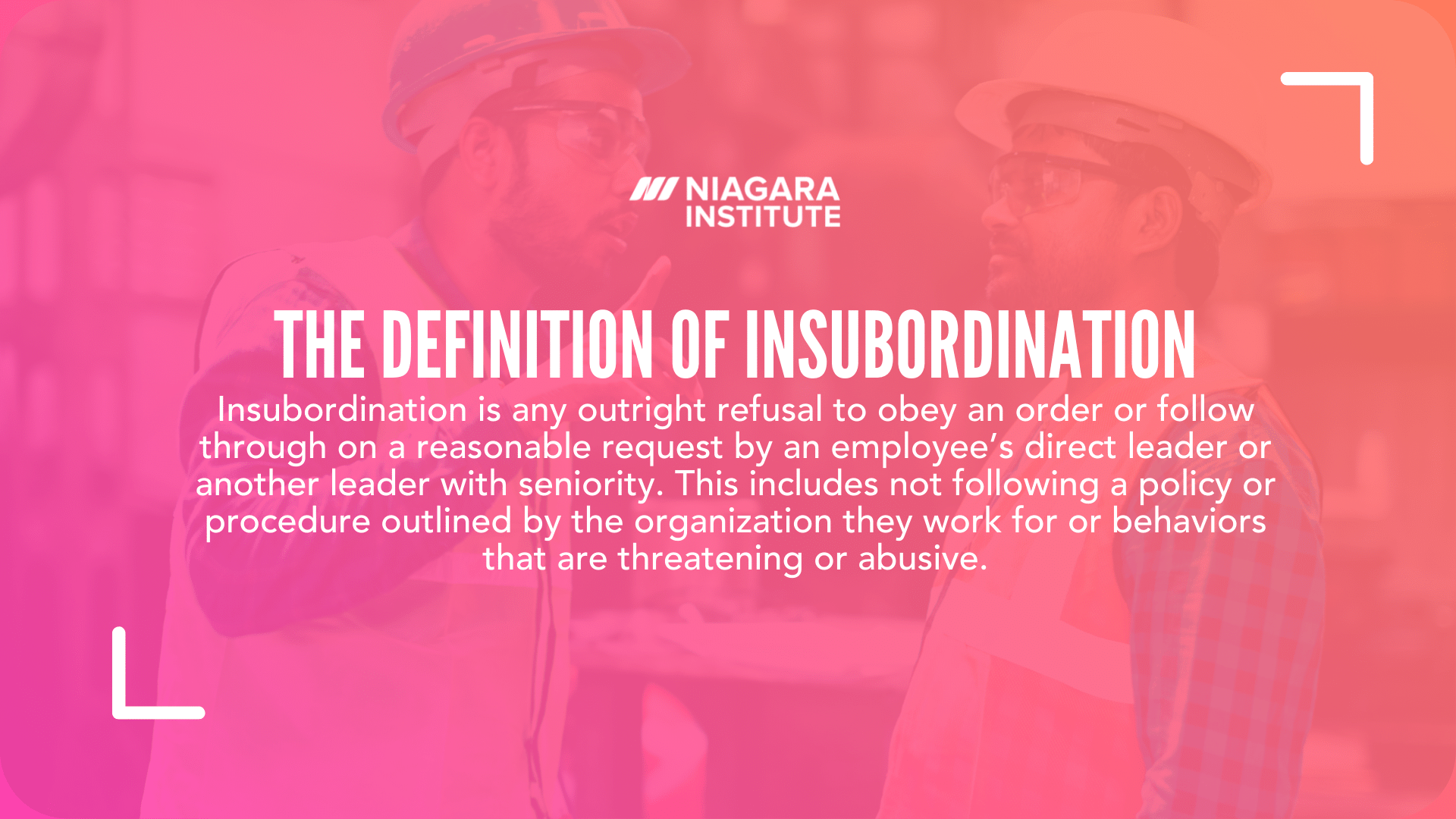6 min read
How Do I Impress My Employees? 10 Leadership Behaviors People Admire
In leadership, every word you say, the action you take, and the decision you make has the potential to impress your employees. Granted, there are...

When an employee doesn’t follow instructions, skirts around their assigned duties, or has a terrible attitude, it can be difficult for any team leader to manage. Not to mention, this type of behavior is toxic to team dynamics as it drags down team cohesion, morale, productivity, and ultimately performance.
Depending on the severity of the behavior of the employee, you may have a situation called insubordination. To help you determine if this is what you are dealing with, let’s recap some of the basics of insubordination.
Insubordination means an employee refuses to obey an order or follow a reasonable request from their direct leader or any seniority. This includes not following a policy or procedure outlined by the organization they work for or threatening or abusive behaviors.
Insubordination is considered a form of misconduct. It involves willful disobedience or disrespect towards a superior's authority, orders, or requests.
Keep in mind that not all situations are equal. Insubordination can mean different things in the workplace. The severity of actions and what is considered insubordination falls on a spectrum and has various disciplinary actions depending on the behavior demonstrated.

Gross insubordination is a severe form of insubordination where an employee not only refuses to follow orders or requests from their direct leader or any senior leader but does so in an especially blatant or disrespectful manner.
This kind of behavior at the workplace can be grounds for termination. When an employee refuses to follow orders, disrespects superiors, or violates company policies, it disrupts workplace harmony and productivity. Depending on the severity and frequency of the behavior, as well as company policies, insubordination can lead to disciplinary action for insubordination, including termination.
An example of such behavior is when an employee repeatedly refuses to complete assigned tasks and openly disrespects their manager during team meetings. Despite multiple warnings, the employee continues this conduct, undermining the authority of their superiors. As a result, the employee can be fired for insubordination.
Sometimes you may think you have a situation where an employee is insubordinate. However, for various reasons, that may not be the case. According to Monkhouse Law, an employment law firm, here are some examples of situations that are not insubordination in the workplace:
Insubordination can take many forms, ranging from minor instances of noncompliance to more severe actions, like gross insubordination mentioned earlier, that significantly disrupt the workplace.
Here are some examples of insubordination at the workplace:
Refusal to follow orders: An employee says "no" when their boss asks them to do something, like refusing to work on a project or following a certain procedure.
Disrespectful behavior: An employee uses rude or offensive language towards their boss, either privately or in front of others, showing they don't respect their formal authority.
Ignoring company policies: An employee repeatedly ignores company rules, like safety guidelines or dress codes, even after being reminded and warned.
Publicly challenging authority: An employee openly questions or criticizes their manager’s decisions during meetings or in front of other team members, undermining their authority.
Persistent noncompliance: An employee consistently fails to complete tasks on time or according to the instructions given, despite multiple reminders and corrective actions from their supervisor.
Hostile actions: An employee shows aggressive behavior towards their boss, such as making threats or engaging in physical confrontations.
These examples illustrate various behaviors that can be considered insubordination, each of which can disrupt the workplace and necessitate appropriate disciplinary action.
One of the most challenging times as a team leader is dealing with difficult situations, such as dealing with insubordination.
To effectively address insubordination in the workplace, it's crucial to understand how to prove insubordination and properly document it.
A detailed insubordination write-up is essential for this process. Start by documenting the incident with specific details, such as the date, time, and nature of the behavior. Collect witness statements and reference the company's code of conduct to demonstrate how the employee's actions violated established policies. Previous warnings and any prior disciplinary actions should also be included to show a pattern of behavior.
Knowing how to deal with employees who don't follow instructions is crucial for maintaining a productive and respectful workplace. No matter how many preventative measures you or your organization may have taken or policies in place, insubordination can happen since you can’t control the behaviors of others.
One of the most challenging times as a team leader is dealing with difficult situations, such as dealing with insubordination. No matter how many preventative measures you or your organization may have taken or policies in place, insubordination can happen since you can’t control the behaviors of others.
As mentioned earlier, an insubordinate employee and their behavior is a spectrum and can have various consequences depending on the severity. In situations where it is less severe and more common, there are four steps leaders should follow.
Leading a team isn’t easy, primarily when insubordination occurs. If you don’t want it to derail your team’s morale and performance, then as difficult as it may be, it is best to immediately take the four steps outlined in this article and then, if necessary, loop in your human resources department.
.png)
6 min read
In leadership, every word you say, the action you take, and the decision you make has the potential to impress your employees. Granted, there are...

7 min read
Whether you call it the great resignation or the great upgrade, the impact is a record number of individuals leaving their employer for a new company...

7 min read
No one in leadership is perfect. Leaders are flawed and as prone to mistakes as anyone else in the workplace. However, sometimes it's bigger than...